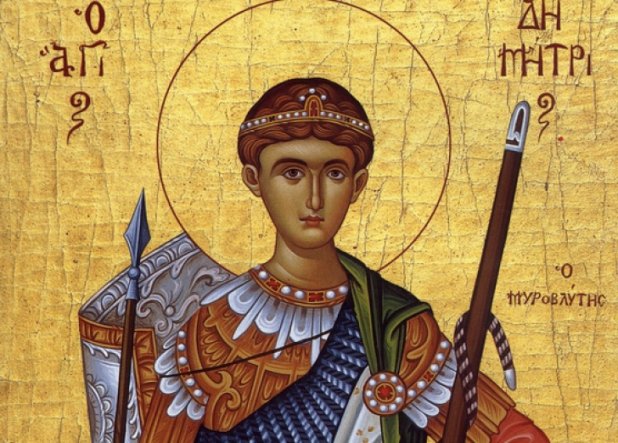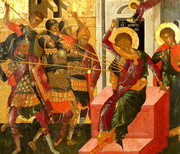Photo credit: (c) LUCIAN TUDOSE / AGERPRES ARCHIVE
Just like some crafts preserved in certain communities, the history of some traditions remains a mystery. One sure thing: they are pre-Christian; they have updated and survived throughout the historic ages. The celebrations of calendar events have turned into holidays for all the community members.
The Mosoaie (a name seemingly meaning ‘old women’) is a unique tradition in Romania, preserved in the village of Luncavita. Since 2013, it has been included in the Calendar of Romanian Village Holidays. Mosoaies’ cowbells are first heard on the night of December 6, St. Nicholas’ Day, kicking off the winter holidays. Wearing sheepskin coats with the fleece out, cowbells on their belts, and masks, the Mosoaie are accompanied by bands of carol singers; they reach every household, or those assigned to them, depending on the tradition of dividing the village into bands, according to the family, the clan, and the girlfriend of a member group. The feast culminates on Christmas Eve, when the Mosoaie pass through the whole village and climb on the central stage of Luncavita.
This is the most archaic Christian practice for locals, Luncavita Mayor Stefan Ilie mentions. The masks, the cowbell noise and the whip cracking are meant to cast out evil and misfortune who try to take over the old year’s end and contaminate the new year about to come.
On Christmas Day, Megleno Romanians in Cerna Village still use to ignite a big oak trunk, called the ‘botnic’, ‘Dedu Botnic’, ‘babnic’ or ‘but’, which is then left to slowly burn until the Baptism of the Lord, celebrated in January, when it pulled out from the fire, relates Dumitra Petrica, President of the Altona Association. The tradition symbolizes the rebirth of divinity; in the nearby village of Izvoarele, Greek locals used to climb on top of the Consul Hill to light a fire.
‘These customs are still practiced on a smaller scale, because tradition must be observed. The meaning is the same, even if nowadays fire is lit in the courtyard,’ the First Deputy President of the Greek Community of Tulcea County Petre Marinescu, a native of Izvoarele, told AGERPRES.
Christmas and New Year habits are found among all the populations, ethnographer Steluta Parau explains. Mask dances are preserved both among Romanians and Ukrainians — the ‘melanka.’
Wishing well with ‘sorcova’ — a decorated twig, used to gently hit the hosts, or pretend to, while singing specific songs, early on New Year Day — is practiced by Romanians, Ukrainians, and Aromanians alike. ‘I could mention some specifics of these traditions: Ukrainians carolling on Christmas Day, not on Christmas Eve, when they have ‘vecera’ [traditional supper]; or the absence of secular carols among the Lipovan [Russian ethnics in and around the Danube Delta],’ Parau details.
On the Baptism of Lord Day, tradition wants attending religious services and blessing horses; horse races follow in many Romanian villages. In Izvoarele, the Greek community has different customs; the Theophany marks a three-day celebration. After the divine service and the horse race, groups of young men led by the ‘dragoman’, the only married man in the group, visit the household of last years’ newlywed and sing songs with dedicated lyrics.
The day is called the Groom’s Bathing, reminding of the walk of the last year’s bridegroom from one well to another, until the carollers got a deal on their reward.
Next comes the Brides’ Day, when the godmothers are actually celebrated; the third day is the Old Women’s Day, dedicated to midwives. No one is allowed to offend women who drank too much on this day.
Lipovan Russians attach special significance to the day before the Easter Lent (equivalent to the Western Christian tradition of Shrove Tuesday or Mardi Gras), the ‘Maslenita’ or the Cheese Week, a secular celebration still held in northern Dobrogea as a merrymaking occasion.
According to Andrian Ampleev, Chairman of the Tulcea County Organization of the Lipovan Russian Community of Romania, the week begins with the meeting day; the second day is dedicated to fun; the third is the delicious day; feast day comes fourth; mother-in-law’s night ends the fifth day; sister-in-law’s night is sixths, and the week ends on Sunday, the forgiveness day. ‘The gifts offered over this week are full of significations and joy. For instance, if the mother-in-law is not happy about her son-in-law, she would not cooks special meals,’ Ampleev details.
Easter, Christmas and New Year are above all religious holidays for Lipovans. The community members go to church wearing traditional suits. The first day of each of these holidays is dedicated to family. The ‘starets’, Russian word for the paterfamilias, sits down first at the table. He is joined by the rest of the family, and then says grace. Like for other ethnic groups, some holiday meals have magic significations attached.
On the Saturday before Palm Sunday, Greeks in Izvoarele honor the tradition of ‘Lazarel’, meaning Little Lazarus. Female carollers lined up in age order wear blue or red velvet suits and white aprons with a ‘zunar’ — a metal belt; young girls also wear white headscarves decorated with silver flowers and rings.
Greek and Romanian language lyrics of the songs evoke Lazarus’s death; according to Tulcea County ethnographers, the ritual wailing are meant to ensure his resurrection in the form of flora. When the song is close to its end, the leader of the young girls group — the ‘buianci’—lays a napkin decorated with embroidered flowers on the host’s shoulder; when the carol is over, the host wishes the girls happy holidays and returns the napkin with a couple of bills folded in it. The girls then get fresh eggs for Easter and a sieve with a flour plate inside, to prepare cakes.
The ‘buianci’ throws the sieve in the courtyard, and the way it falls tells the host how the year will be — good, if the sieve is facing up, and less prosperous, if it felled face down.
Saint George’s Day, celebrated according to the ‘Old-Style’ (Julian calendar), is the day when last years’ new-borns are ritually stolen. The ‘kidnappers’ then bathe them in water with money — bidding them richness, and flowers — calling for nicely growing, and dress them in new clothes before returning them to their parents; the latter respond with presents to those who return their precious babies.
The ‘Kurban’ custom marks the end of the New Year holidays; each family sacrifices a lamb and invite friends and relative to taste the dishes prepared from it.
During the Easter Lent, on Saint Theodore’s Day, the village of Cerna had a Bulgarian tradition observed until 1940, when Romania and Bulgaria exchanged populations in Dobrogea (southeastern Romania; it includes Tulcea County) and the neighbouring province of Cadrilater (the Quadrilateral, sometimes called Southern Dobrogea — or Dobruja, in northeastern Bulgaria).
‘In 2013, in a folk festival in Nova Cerna (New Cerna) in Bulgaria, I have met relatives of people who lived in Cerna before World War II; they had fond memories of our places, and especially of the horse races back then. It was called the ‘Cosia’; it was held on Saint Theodore’s Day, on seven kilometres; the winners were awarded beehives, calves, sheep, horseshoes, or harnesses,’ the Altona Association President Dumitra Petrica recalls.
Therefore, the tradition was revived last year, after 73 years of interruption, with the support of the municipal authorities and of the Macin Mountains National Park Administration; Cerna became the host of folk events, local product fairs, and of the horse race, to be held at the beginning of each tourist season.
Aromanians, who call themselves ‘Armani’ or ‘Machidoni’, used to be ‘carvanari’, carrying precious freight in caravans from Constantinople to western Europe, or shepherds, living in the mountains from spring to autumn, says Sterica Fundulea, the president of this community in Tulcea County.
On the day of Saint Demetrius, patron of shepherds, Aromanians descended for winter to the Thessaly plain and around the Aegean Sea; the moment was marked by celebrations involving dances, songs, and various rituals.
‘One of the books dedicated to the Armanis’ way of living reads, ‘When they descended with their flocks from Xirulivad for winter, the whole plain used to echo with sheep bleating, with sheep bell sounds, and with barking of big, long-haired dogs.’ The passing of flocks itself was a savage opulence show, watched by town dwellers who got in the open to see Armanis’ sheep. As transhumance is no longer practiced in the Balkans, only the holiday remains, ‘ Fudulea recites.
The International Shepherd festival is held every year in May, in the village of Sarighiol de Deal; the town of Tulcea also hosts some folk shows of the festival. Exhibitions of specific items of the traditional trade accompany the event; guests are offered traditional food.
The ‘Hidrellez’ is a pre-Islamic holiday celebrated by Turkic people from immemorial times. For them, the 6th of May is the beginning of a new season — the summer; farmers get their animals out of the stables, which thei clean and smoke against the ‘evil eye.’ A couple of handfuls of what grains poured on the window sills on this day were supposed to bring abundant crops. Children used to rub themselves with garlic to keep bad dreams away. ‘Kalakay’ — small breads prepared by housewives the day before — are rolled down from a hill to forecast the fate of the years’ crops.
During the next morning, after the divine service, the housewives milk the cows and sheep, and pour the milk on the stable door sill to bring even more of abundance. The youth have to gather every flammable item and prepare a fire near the mosque. The village elder lights the fire after the service, and he is the first to jump through it for purification. Women jump last, when flames are down. Traditional ‘Kures’ Tatar wrestling follows. Girls sway on swings decorated with flowers; women go to cemeteries to honour the dead. The afternoon meal, served outdoors, gathers the whole family.
Irrespective of their populations, no matter how remote or promoted their communities are, all the ethnic minorities in Tulcea County preserve their traditions along the year and those related to the cycle of life; there are Rroma, Ukrainians, Germans, Turks, Lipovan Russians, Tatars, Serbs, Slovaks, Bulgarians, Greeks, Italians, Jews, Poles, Armenians, Csangos, Macedonians, and Hungarians. The multicultural character in Dobrogea is visible in dwellings’ features, traditional suits, gastronomy, legends, dances, and songs.
‘A couple of years ago, we have organized a traditional event, the Carnavale, specific to the Italian community in Greci; a guest from Italy was deeply moved by songs he hadn’t heard since his childhood, when his grandmother used to sing to him,’ the Greci Italian Community President Sorin Vals recalls.
Artist Grigore Lese, after a documentary visit to remote villages in the terrace region of Tulcea County in 2007, told AGERPRES, ‘It was an extraordinary experience to meet six men of Caugagia singing traditional polyphonic songs. It is a valuable culture that could make us famous throughout Europe.’
These are just a few reasons for the authorities to host public events each year; for instance, the Children’s International Folklore Festival ‘The Golden Fish,’ hosted in Tulcea in August. It confirms once more the county’s fame of a miniature Europe. AGERPRES



































